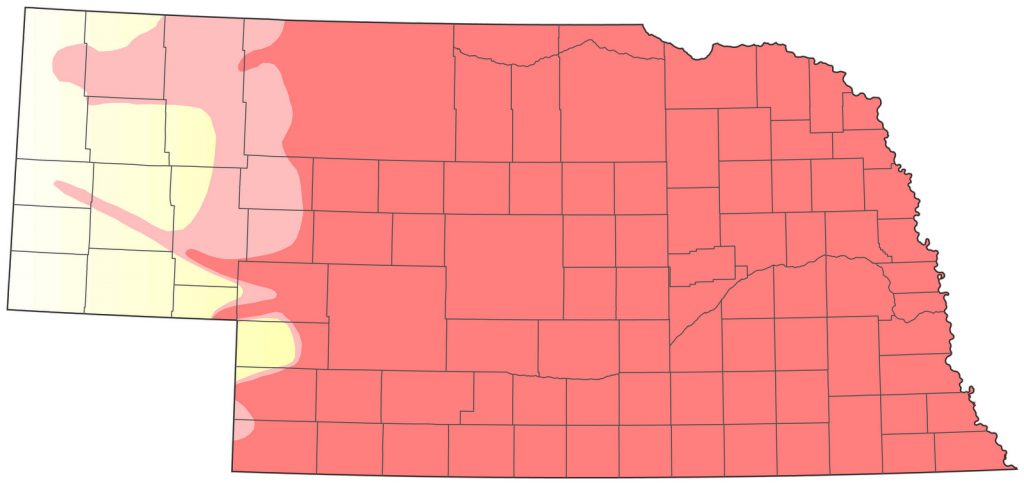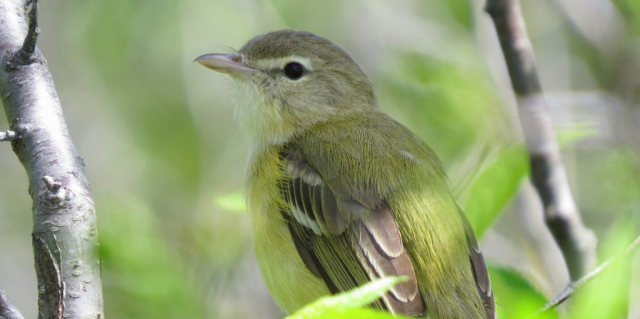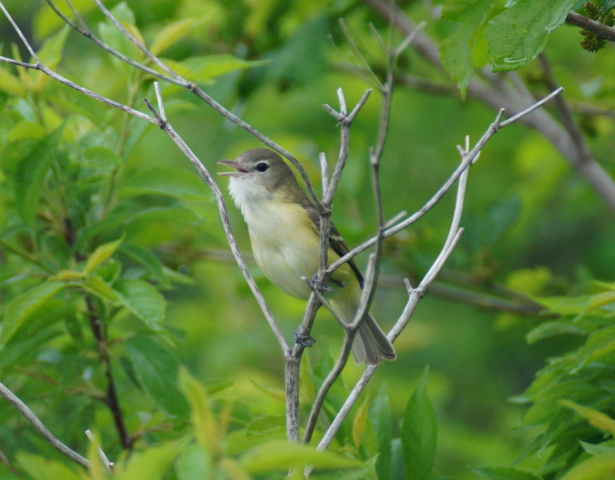Vireo bellii bellii
Status: Increasing. Fairly common regular spring and fall migrant east and central, uncommon west. Common regular breeder central, fairly common east, rare west.

Documentation: Specimen: UNSM ZM10541, 12 Aug 1907 (two birds) Lincoln, Lancaster Co.
Taxonomy: Four subspecies are recognized (AviList 2025), pusillus of southern California, arizonae of the southwestern US into Mexico, medius of southern New Mexico and west Texas, and bellii of the central and southern USA.
Nebraska birds are bellii.
Spring: Apr 29, 30, 30 <<<>>> summer (east), May 4, 4, 5 <<<>>> summer (central), May 20, 20, 21 <<<>>> summer (west)
Earlier dates in the east are 11 Apr 2009 Butler Co, and 17 Apr 2017 Lancaster Co; in the central 2 May 2020 Keya Paha Co; in the west 7 May 2002 Crescent Lake NWR, Garden Co, 13 May 2025 Gordon, Sheridan Co, 14 May 2022 Ash Hollow SHP, Garden Co, 15 May 2020 Kimball Co, and 16 May 2022 Lewellen, Garden Co.
First arrivals are in the east, becoming progressively later westward, especially in the Panhandle. Kus et al (2020) noted that arrival is later at higher elevations and northward.
- High counts: 46 at Rock Creek SRA, Dundy Co 26 May 2019, 34 at Calamus Reservoir, Loup Co 24 May 1997, 29 at Rock Creek SRA 14 May 2022, and 24 there 17 May 2023.
Summer: Although this species breeds statewide, it is near the northwestern extent of its US summer range. It is least numerous in western Sandhills grasslands and in the Panhandle, where extensive brushy habitat is lacking; Jorgensen (2012) noted that it is also largely absent as a breeder from the Rainwater Basin because of limited habitat. However, Mollhoff (2016) showed a small number of records from this latter landscape. Overall, it is increasing in numbers; the BBS Trend analysis shows Bell’s Vireo has increased at an impressive average rate of 3.37% (95% C.I.; 1.78, 5.11) per year statewide during the period 1966-2019 (Sauer et al 2020). BBS trend map analysis shows that increases have occurred in all areas except for the Panhandle, where there are few data. Changes in the amount and distribution of breeding habitat due to human intervention has likely attributed to local and regional increases, as the absence of disturbance regimes, such as fire, has allowed expansion of shrub habitat. Rosche (1994) noted that “inadequate stream flow” in the North Platte River channel in Keith Co has allowed dense riparian brush to return, benefitting this species in recent years. However, clearing of brush along watercourses, such as along the central Platte River, and reintroducing fire regimes tend to reduce the extent of breeding habitat.
Along the Niobrara River Valley, Kus et al (2020) depicted the range as continuous west to the Pine Ridge; it is indeed common west to NNF McKelvie, Merritt Reservoir, and Valentine NWR in Cherry Co, but between there and the Pine Ridge numbers are low; the records are listed below under western Sandhills.
On the Pine Ridge, Ducey (1988) cited a breeding record for Dawes Co in 1966. Most reports are from Fort Robinson SP and SRA, Sioux and Dawes Cos: from 2010-2021 there were eight such reports of 1-3 birds 20 May-22 Jul, and in 2025 four reports of 1-2 birds 3-8 Jun. Three were at the Sandcreek Road area, Ogallala NG Sioux Co 25 Jun 2025. Elsewhere on the Pine Ridge since 2008 there have been these reports: two on 10 Jun 2015 Ponderosa WMA, Dawes Co, 1-3 on 10-11 Jun 2015 Chadron SP, one on 13 Jun 2009 in Dawes Co, 1-2 on 19-20 Jun 2018 in Kings Canyon, Dawes Co, 1-2 on 4-6 Jul 2024 NNF Soldier Creek, Sioux Co, two on 8 Jul 2023 along West Ash Creek Road, Dawes Co, 19 Jul 2019 Chadron Reservoirs, Dawes Co, and two on 29 Jul 2023 along Breakneck Road, Dawes Co.
In the western Sandhills and Panhandle (south of the Pine Ridge, west of Lewellen, north of the South Platte River Valley), numbers are low. Ducey (1988) cited a breeding record for Scotts Bluff Co in 1964, Johnsgard (1979) stated that it was absent in most of the Panhandle except for the White River Valley, and Rosche (1982) considered it rare to uncommon in the northwest, with “no nesting evidence”. There were reports 15-17 Jul 1986 at four Garden Co locations (Williams 1987). In recent years reports have increased; of a total of 23 reports, eight have occurred 2023-2025.
- Breeding Phenology:
Eggs: 9 May- 23 Jul (Mollhoff 2022)
Nestlings: 16 May-27 Jul
Fledglings: 6- 27 Jul - High counts: 36 at Rock Creek SRA, Dundy Co 18 Jul 2020.
Fall: summer <<<>>> Sep 13, 14, 15 (north, west); summer <<<>>> Sep 21, 22, 23 (south, east)
Later dates in the south and east are 24 Sep 2018 Hall Co, 30 Sep 2009 Dodge Co, 5 Oct 2009 Dodge Co, and 8 Oct 1996 Otoe Co (Falk 2002).
Later dates in the north and west are 16 Sep 2008 Cherry Co, 19 Sep 2013 Custer Co, 23 Sep 2015 Thomas Co, 25 Sep 1999 Loup Co, 25 Sep 2019 Valentine NWR, Cherry Co, 25 Sep 2009 Custer Co, 3 Oct 2008 Scotts Bluff Co.
Departure in the north and west is completed by early Sep, and in the south and east by mid-Sep.
There are only about 17 Panhandle reports after 24 Jul and west of Lewellen in North Platte Valley; latest are 30 Aug 2021 Cheyenne Co, 1 Sep 2020 Wright’s Gap Road, Banner Co, 2 Sep 2021 Dawes Co, 14 Sep 2013 Oliver Reservoir SRA, Kimball Co, and 3 Oct 2008 Scotts Bluff Co.
- High counts: 51 at Rock Creek SRA, Dundy Co 9 Aug 2020, 36 there 22 Aug 2022, 30 at Calamus Reservoir 20 Aug 1995, 30 there 7 Sep 1997, and 28 at Rock Creek SRA, Dundy Co 1 Sep 2018.
Images
Abbreviations
BBS: Breeding Bird Survey
NG: National Grasslands
NNF: Nebraska National Forest
NWR: National Wildlife Refuge
SHP: State Historical Park
SP: State Park
SRA: State Recreation Area
UNSM: University of Nebraska State Museum
WMA: Wildlife Management Area (State)
Literature Cited
AviList Core Team, 2025. AviList: The Global Avian Checklist, v2025. https://doi.org/10.2173/avilist.v2025.
Ducey, J.E. 1988. Nebraska birds, breeding status and distribution. Simmons-Boardman Books, Omaha, Nebraska, USA.
Falk, L. 2002. Birds in Otoe County. Published by the author, Nebraska City, Nebraska, USA.
Johnsgard, P.A. 1979. Birds of the Great Plains: breeding species and their distribution. University of Nebraska Press, Lincoln, Nebraska, USA.
Jorgensen, J.G. 2012. Birds of the Rainwater Basin, Nebraska. Nebraska Game and Parks Commission, Lincoln, Nebraska, USA.
Kus, B., S.L. Hopp, R.R. Johnson, and B.T. Brown. 2020. Bell’s Vireo (Vireo bellii), version 1.0. In Birds of the World (A. F. Poole, Editor). Cornell Lab of Ornithology, Ithaca, NY, USA. https://doi.org/10.2173/bow.belvir.01.
Mollhoff, W.J. 2016. The Second Nebraska Breeding Bird Atlas. Bull. Univ. Nebraska State Museum Vol 29. University of Nebraska State Museum, Lincoln, Nebraska, USA.
Mollhoff, W.J. 2022. Nest records of Nebraska birds. Nebraska Ornithologists’ Union Occasional Paper Number 9.
Rosche, R.C. 1982. Birds of northwestern Nebraska and southwestern South Dakota, an annotated checklist. Cottonwood Press, Crawford, Nebraska, USA.
Rosche, R.C. 1994. Birds of the Lake McConaughy area and the North Platte River valley, Nebraska. Published by the author, Chadron, Nebraska, USA.
Sauer, J.R., Link, W.A., and Hines, J.E. 2020. The North American Breeding Bird Survey, Analysis Results 1966 – 2019: U.S. Geological Survey data release, https://doi.org/10.5066/P96A7675.
Williams, F. 1987. Southern Great Plains Region. American Birds 41: 454-458.
Recommended Citation
Silcock, W.R., and J.G. Jorgensen. 2025. Bell’s Vireo (Vireo bellii). In Birds of Nebraska — Online. www.BirdsofNebraska.org
Birds of Nebraska – Online
Updated 13 Sep 2025


